how to fix sore throat
Sore throat is pain in the posterior pharynx that occurs with or without swallowing. Pain can be severe; many patients refuse oral intake.
Sore throat results from infection; the most common cause is
-
Tonsillopharyngitis
Rarely, an abscess or epiglottitis is involved; although uncommon, these are of particular concern because they may compromise the airway.
Tonsillopharyngitis is predominantly a viral infection; a lesser number of cases are caused by bacteria.
The respiratory viruses Overview of Viral Respiratory Infections Viral infections commonly affect the upper or lower respiratory tract. Although respiratory infections can be classified by the causative virus (eg, influenza), they are generally classified... read more (rhinovirus, adenovirus, influenza, coronavirus, respiratory syncytial virus) are the most common viral causes, but occasionally Epstein-Barr virus Infectious Mononucleosis Infectious mononucleosis is caused by Epstein-Barr virus (EBV, human herpesvirus type 4) and is characterized by fatigue, fever, pharyngitis, and lymphadenopathy. Fatigue may persist weeks or... read more 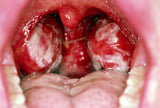 (the cause of mononucleosis), herpes simplex Herpes Simplex Virus (HSV) Infections Herpes simplex viruses (human herpesviruses types 1 and 2) commonly cause recurrent infection affecting the skin, mouth, lips, eyes, and genitals. Common severe infections include encephalitis... read more
(the cause of mononucleosis), herpes simplex Herpes Simplex Virus (HSV) Infections Herpes simplex viruses (human herpesviruses types 1 and 2) commonly cause recurrent infection affecting the skin, mouth, lips, eyes, and genitals. Common severe infections include encephalitis... read more 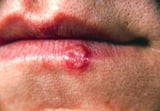 , cytomegalovirus Cytomegalovirus (CMV) Infection Cytomegalovirus (CMV, human herpesvirus type 5) can cause infections that have a wide range of severity. A syndrome of infectious mononucleosis that lacks severe pharyngitis is common. Severe... read more , or primary HIV infection Human Immunodeficiency Virus (HIV) Infection Human immunodeficiency virus (HIV) infection results from 1 of 2 similar retroviruses (HIV-1 and HIV-2) that destroy CD4+ lymphocytes and impair cell-mediated immunity, increasing risk of certain... read more
, cytomegalovirus Cytomegalovirus (CMV) Infection Cytomegalovirus (CMV, human herpesvirus type 5) can cause infections that have a wide range of severity. A syndrome of infectious mononucleosis that lacks severe pharyngitis is common. Severe... read more , or primary HIV infection Human Immunodeficiency Virus (HIV) Infection Human immunodeficiency virus (HIV) infection results from 1 of 2 similar retroviruses (HIV-1 and HIV-2) that destroy CD4+ lymphocytes and impair cell-mediated immunity, increasing risk of certain... read more  is involved.
is involved.
The main bacterial cause is group A beta-hemolytic streptococci (GABHS Streptococcal Infections Streptococci are gram-positive aerobic organisms that cause many disorders, including pharyngitis, pneumonia, wound and skin infections, sepsis, and endocarditis. Symptoms vary with the organ... read more 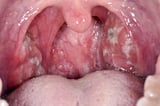 ), which, although estimates vary, causes perhaps 10% of cases in adults and slightly more in children. GABHS is a concern because of the possibility of the poststreptococcal sequelae of rheumatic fever, glomerulonephritis, and abscess. Uncommon bacterial causes include gonorrhea Gonorrhea Gonorrhea is caused by the bacteria Neisseria gonorrhoeae. It typically infects epithelia of the urethra, cervix, rectum, pharynx, or conjunctivae, causing irritation or pain and purulent discharge... read more
), which, although estimates vary, causes perhaps 10% of cases in adults and slightly more in children. GABHS is a concern because of the possibility of the poststreptococcal sequelae of rheumatic fever, glomerulonephritis, and abscess. Uncommon bacterial causes include gonorrhea Gonorrhea Gonorrhea is caused by the bacteria Neisseria gonorrhoeae. It typically infects epithelia of the urethra, cervix, rectum, pharynx, or conjunctivae, causing irritation or pain and purulent discharge... read more 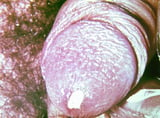 , diphtheria Diphtheria Diphtheria is an acute pharyngeal or cutaneous infection caused mainly by toxigenic strains of the gram-positive bacillusCorynebacterium diphtheriae and rarely by other, less common Corynebacterium... read more
, diphtheria Diphtheria Diphtheria is an acute pharyngeal or cutaneous infection caused mainly by toxigenic strains of the gram-positive bacillusCorynebacterium diphtheriae and rarely by other, less common Corynebacterium... read more  , mycoplasma Mycoplasmas Mycoplasmas are ubiquitous bacteria that differ from other prokaryotes in that they lack a cell wall. Mycoplasma pneumoniae is a common cause of pneumonia, particularly community-acquired pneumonia... read more , and chlamydia Chlamydia Three species of Chlamydia cause human disease, including sexually transmitted infections and respiratory infections. All are susceptible to macrolides (eg, azithromycin), tetracyclines (eg... read more .
, mycoplasma Mycoplasmas Mycoplasmas are ubiquitous bacteria that differ from other prokaryotes in that they lack a cell wall. Mycoplasma pneumoniae is a common cause of pneumonia, particularly community-acquired pneumonia... read more , and chlamydia Chlamydia Three species of Chlamydia cause human disease, including sexually transmitted infections and respiratory infections. All are susceptible to macrolides (eg, azithromycin), tetracyclines (eg... read more .
An abscess in the pharyngeal area (peritonsillar Peritonsillar Abscess and Cellulitis Peritonsillar abscess and cellulitis are acute pharyngeal infections most common among adolescents and young adults. Symptoms are severe sore throat, trismus, "hot potato" voice, and uvular... read more 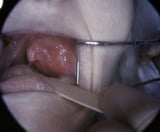 , parapharyngeal Parapharyngeal Abscess A parapharyngeal abscess is a deep neck abscess. Symptoms include fever, sore throat, odynophagia, and swelling in the neck down to the hyoid bone. Diagnosis is by CT. Treatment is antibiotics... read more
, parapharyngeal Parapharyngeal Abscess A parapharyngeal abscess is a deep neck abscess. Symptoms include fever, sore throat, odynophagia, and swelling in the neck down to the hyoid bone. Diagnosis is by CT. Treatment is antibiotics... read more  , and, in children, retropharyngeal Retropharyngeal Abscess Retropharyngeal abscesses, most common among young children, can cause sore throat, fever, neck stiffness, and stridor. Diagnosis requires lateral neck x-ray or CT. Treatment is with endotracheal... read more
, and, in children, retropharyngeal Retropharyngeal Abscess Retropharyngeal abscesses, most common among young children, can cause sore throat, fever, neck stiffness, and stridor. Diagnosis requires lateral neck x-ray or CT. Treatment is with endotracheal... read more  ) is uncommon but causes significant throat pain. The usual causative organism is GABHS.
) is uncommon but causes significant throat pain. The usual causative organism is GABHS.
Epiglottitis Epiglottitis Epiglottitis is a rapidly progressive bacterial infection of the epiglottis and surrounding tissues that may lead to sudden respiratory obstruction and death. Symptoms include severe sore throat... read more 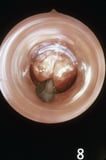 , perhaps better termed supraglottitis, used to occur primarily in children and usually was caused by Haemophilus influenzae type B (HiB). Now, because of widespread childhood vaccination against HiB, supraglottitis/epiglottitis has been almost eradicated in children (more cases occur in adults). Causal organisms in children and adults include Streptococcus pneumoniae, Staphylococcus aureus, nontypeable H. influenzae, Haemophilus parainfluenzae, beta-hemolytic streptococci, Branhamella catarrhalis, and Klebsiella pneumoniae. HiB is still a cause in adults and unvaccinated children.
, perhaps better termed supraglottitis, used to occur primarily in children and usually was caused by Haemophilus influenzae type B (HiB). Now, because of widespread childhood vaccination against HiB, supraglottitis/epiglottitis has been almost eradicated in children (more cases occur in adults). Causal organisms in children and adults include Streptococcus pneumoniae, Staphylococcus aureus, nontypeable H. influenzae, Haemophilus parainfluenzae, beta-hemolytic streptococci, Branhamella catarrhalis, and Klebsiella pneumoniae. HiB is still a cause in adults and unvaccinated children.
History of present illness should note the duration and severity of sore throat.
Review of systems should seek important associated symptoms, such as runny nose, cough, and difficulty swallowing, speaking, or breathing. The presence and duration of any preceding weakness and malaise (suggesting mononucleosis) are noted.
Past medical history should seek history of previous documented mononucleosis (recurrence is highly unlikely). Social history should inquire about close contact with people with documented GABHS infection, risk factors for gonorrhea transmission (eg, recent oral-genital sexual contact), and risk factors for HIV acquisition (eg, unprotected intercourse, multiple sex partners, IV drug abuse).
General examination should note fever and signs of respiratory distress, such as tachypnea, dyspnea, stridor, and, in children, the tripod position (sitting upright, leaning forward with neck hyperextended and jaw thrust forward).
Pharyngeal examination should not be done in children if supraglottitis/epiglottitis is suspected, because it may trigger complete airway obstruction. Adults with no respiratory distress may be examined but with care. Erythema, exudates, and any signs of swelling around the tonsils or retropharyngeal area should be noted. Whether the uvula is in the midline or appears pushed to one side should also be noted.
The neck is examined for presence of enlarged, tender lymph nodes. The abdomen is palpated for presence of splenomegaly.
The following findings are of particular concern:
-
Stridor or other sign of respiratory distress
-
Drooling
-
Muffled, "hot potato" voice
-
Visible bulge in pharynx
With supraglottitis/epiglottitis, there is abrupt onset of severe throat pain and dysphagia, usually with no preceding upper respiratory infection (URI) symptoms. Children often have drooling and signs of toxicity. Sometimes (more often in children), there are respiratory manifestations, with tachypnea, dyspnea, stridor, and sitting in the tripod position. If examined, the pharynx almost always appears unremarkable.
Pharyngeal abscess and tonsillopharyngitis both may cause pharyngeal erythema, exudate, or both. However, some findings are more likely in one condition or another:
-
Pharyngeal abscess: Muffled, "hot potato" voice (speaking as if a hot object is being held in the mouth); visible focal swelling in the posterior pharyngeal area (often with deviation of the uvula)
-
Tonsillopharyngitis: Often accompanied by URI symptoms (eg, runny nose, cough)
-
Tonsillar exudate
-
Tender lymphadenopathy
-
Fever (including history)
-
Absence of cough
Adults with ≤ 1 criterion reasonably may be presumed to have viral illness. If ≥ 2 criteria are present, the likelihood of GABHS is high enough to warrant testing but probably not high enough to warrant antibiotics, but this decision needs to be patient-specific (ie, threshold for testing and treatment may be lower in those at risk because of diabetes or immunocompromise). In children, testing usually is done. Although this approach is reasonable, not all experts agree on when to test for GABHS and when antibiotic treatment is indicated.
Regarding rarer causes of tonsillopharyngitis, infectious mononucleosis Infectious Mononucleosis Infectious mononucleosis is caused by Epstein-Barr virus (EBV, human herpesvirus type 4) and is characterized by fatigue, fever, pharyngitis, and lymphadenopathy. Fatigue may persist weeks or... read more  should be considered when there is posterior cervical or generalized adenopathy, hepatosplenomegaly, and fatigue and malaise for > 1 week. Patients with no URI symptoms but recent oral-genital contact may have pharyngeal gonorrhea Gonorrhea Gonorrhea is caused by the bacteria Neisseria gonorrhoeae. It typically infects epithelia of the urethra, cervix, rectum, pharynx, or conjunctivae, causing irritation or pain and purulent discharge... read more
should be considered when there is posterior cervical or generalized adenopathy, hepatosplenomegaly, and fatigue and malaise for > 1 week. Patients with no URI symptoms but recent oral-genital contact may have pharyngeal gonorrhea Gonorrhea Gonorrhea is caused by the bacteria Neisseria gonorrhoeae. It typically infects epithelia of the urethra, cervix, rectum, pharynx, or conjunctivae, causing irritation or pain and purulent discharge... read more  . A dirty-gray, thick, tough membrane on the posterior pharynx that bleeds if peeled away indicates diphtheria Diphtheria Diphtheria is an acute pharyngeal or cutaneous infection caused mainly by toxigenic strains of the gram-positive bacillusCorynebacterium diphtheriae and rarely by other, less common Corynebacterium... read more
. A dirty-gray, thick, tough membrane on the posterior pharynx that bleeds if peeled away indicates diphtheria Diphtheria Diphtheria is an acute pharyngeal or cutaneous infection caused mainly by toxigenic strains of the gram-positive bacillusCorynebacterium diphtheriae and rarely by other, less common Corynebacterium... read more  (rare in the US). HIV Human Immunodeficiency Virus (HIV) Infection Human immunodeficiency virus (HIV) infection results from 1 of 2 similar retroviruses (HIV-1 and HIV-2) that destroy CD4+ lymphocytes and impair cell-mediated immunity, increasing risk of certain... read more
(rare in the US). HIV Human Immunodeficiency Virus (HIV) Infection Human immunodeficiency virus (HIV) infection results from 1 of 2 similar retroviruses (HIV-1 and HIV-2) that destroy CD4+ lymphocytes and impair cell-mediated immunity, increasing risk of certain... read more  infection should be considered in patients with risk factors.
infection should be considered in patients with risk factors.
If supraglottitis/epiglottitis is considered possible after evaluation, testing is required. Patients who do not appear seriously ill and have no respiratory symptoms may have plain lateral neck x-rays to look for an edematous epiglottis. However, a child who appears seriously ill or has stridor or any other respiratory symptoms should not be transported to the x-ray suite. Such patients (and those with positive or equivocal x-ray findings) usually should have flexible fiberoptic laryngoscopy. (CAUTION: Examination of the pharynx and larynx may precipitate complete respiratory obstruction in children, and the pharynx and larynx should not be directly examined except in the operating room, where the most advanced airway intervention is available.)
Many abscesses are managed clinically, but if location and extent are unclear, immediate CT of the neck should be done.
In tonsillopharyngitis, throat culture is the only reliable way to differentiate viral infection from GABHS. To balance timeliness of diagnosis, cost, and accuracy, one strategy in children is to do a rapid strep screen in the office, treat if positive, and send a formal culture if negative. In adults, because other bacterial pathogens may be involved, throat culture for all bacterial pathogens is appropriate for those meeting clinical criteria described previously.
Testing for mononucleosis, gonorrhea, or HIV is done only when clinically suspected.
Specific conditions are treated. Patients with severe symptoms of tonsillopharyngitis may be started on a broad-spectrum antibiotic (eg, amoxicillin/clavulanate) pending culture results.
Symptomatic treatments such as warm saltwater gargles and topical anesthetics (eg, benzocaine, lidocaine, dyclonine) may help temporarily relieve pain in tonsillopharyngitis. Patients in severe pain (even from tonsillopharyngitis) may require short-term use of opioids.
Corticosteroids (eg, dexamethasone, 10 mg IM) are occasionally used, for example, for tonsillopharyngitis that appears to pose a risk of airway obstruction (eg, due to mononucleosis) or very severe tonsillopharyngitis symptoms.
-
Most sore throats are caused by viral tonsillopharyngitis.
-
It is difficult to clinically distinguish viral from bacterial causes of tonsillopharyngitis.
-
Abscess and epiglottitis are rare but serious causes.
-
Severe sore throat in a patient with a normal-appearing pharynx should raise suspicion of epiglottitis.
how to fix sore throat
Source: https://www.msdmanuals.com/professional/ear,-nose,-and-throat-disorders/approach-to-the-patient-with-nasal-and-pharyngeal-symptoms/sore-throat
Posted by: justicebeirsed.blogspot.com

0 Response to "how to fix sore throat"
Post a Comment